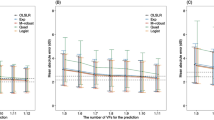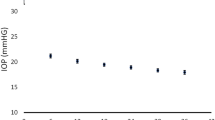Abstract
• Background: Use of statistical modelling techniques to identify models that both describe glaucomatous sensitivity decay and allow predictions of future field status. • Method: Twelve initially normal fellow eyes of untreated patients with confirmed normal-tension glaucoma were studied. All had in excess of 15 Humphrey fields (mean follow-up 5.7 years). From this cohort individual field locations were selected for analysis if they demonstrated unequivocal deterioration at the final two fields. Forty-seven locations from five eyes satisfied this criterion and were analysed using curve-fitting software which automatically applies 221 different models to sensitivity (y) against time of follow up (x). Curve-fitting was then repeated on the first five fields, followed by projection to the date of the final field to generate a predicted threshold which was compared to the actual threshold. Competing models were therefore assessed on their performance at adequately fitting the data (R 2) and their potential to predict future field status. • Results: Models that provided the best fit to the data were all complex polynomial expressions (median R 2 0.93). Other simple expressions fitted fewer locations and exhibited lower R 2 values. However, accuracy in predicting future deterioration was superior with these less complex models. In this group a linear expression demonstrated an adequate fit to the majority of the data and generated the most accurate predictions of future field status. • Conclusions: A linear model of the pointwise sensitivity values against time of follow-up can provide a framework for detecting and forecasting glaucomatous field progression. Linear modelling allows the clinically important rate of sensitivity loss to be estimated.
Similar content being viewed by others
References
Zulauf M, Caprioli J (1992) What constitutes progression of glaucomatous visual field defects? Semin Ophthalmol 7: 130–146
Piltz JR, Drance SM, Douglas GR, Mikelberg FS (1991) The relationship of peripheral vasospasm, diffuse and localised visual field defects and intra-ocular pressure in glaucomatous eyes. In: Mills RP, Heijl A (eds) Perimetry update 1990/91. Kugler and Ghendini, Amsterdam, pp 465–472
Heijl A, Lindgren G, Olsson J (1987) Normal variability of static perimetry threshold values across the central visual field. Arch Ophthalmol 105:1544–1549
Glicklich RE, Steinman WC, Spaeth GL (1989) Visual field change in low tension glaucoma over a five year follow up. Ophthalmology 96:316–320
Zeyen TG, Caprioli J (1993) Progression of disc and field damage in early glaucoma. Arch Ophthalmol 11:62–65
Chatfield C (1989) The analysis of time series, 4th edn. Chapman and Hall, London, pp 66–85
Shultzer M, Mills RP, Hopp RH, Wing L, Drance SM (1990) Estimation of the short-term fluctuation from a single determination of the visual field. Invest Ophthalmol Vis Sci 31:730–735
Mikelberg FS, Drance SM (1984) The rate of progression of scotomas in glaucoma. Am J Ophthalmol 98:443–445
O'Brien C, Schwartz B (1990) The visual field in chronic open angle glaucoma: the rate of change in different regions of the field. Eye 4:557–562
O'Brien C, Schwartz B (1993) Point by point linear regression analysis of automated visual fields in primary open angle glaucoma. In: Mills RP (ed) Perimetry update 1992/93. Kugler, Amsterdam, pp 149–152
Noureddin BN, Poinoosawmy D, Fitzke FW, Hitchings RA (1991) Regression analysis of visual field progression in low tension glaucoma. Br J Ophthalmol 75:493–495
Wild JM, Hutchings N, Hussey MK, Flanagan JG, Trope GE (1994) Univariate linear regression of pointwise visual field sensitivity against time of follow-up. ARVO abstracts. Invest Ophthalmol Vis Sci 35 [Suppl]:4306
Wild JM, Hussey MK, Flanagan JG, Trope GE (1993) Pointwise topographical and longitudinal modeling of the visual field in glaucoma. Invest Ophthalmol Vis Sci 34:1907–1916
Asman P, Heijl A, Olsson J, Rootzen H (1992) Spatial analyses of glaucomatous visual fields: a comparison with traditional visual field indices. Acta Ophthalmol 70:679–686
Lachenmayr B, Kiermeir U, Kojetinsky S (1994) Neighbouring points of a normal visual field are not statistically independent. ARVO abstracts. Invest Ophthalmol Vis Sci 35 [Suppl]: 313
Chauhan BC, Drance SM, Douglas GR (1990) The use of visual field indices in detecting the changes in the visual field in glaucoma. Invest Ophthalmol Vis Sci 31:512–520
Crabb DP, Fitzke FW, Edgar DF, McNaught Al (1994) Improving the analysis of glaucomatous visual field data with image processing techniques. ARVO abstracts. Invest Ophthalmol Vis Sci 35 [Suppl]:4283
Crabb DP, McNaught Al, Fitzke FW, Hitchings RA (1995) Spatially enhanced modelling of sensitivity decay in low tension glaucoma. In: Mills RP, Wall M (eds) Perimetry update 1994/95. Amsterdam: Kugler, Amsterdam, pp 73–81
Fitzke FW, Crabb DP, McNaught AI, Edgar DF, Hitchings RA (1995) Image processing of computerised visual field data. Br J Ophthalmol 79: 207–212
Fitzke FW, McNaught AI (1994) The diagnosis of visual field progression in glaucoma. Curr Opin Ophthalmol 5:110–115
Author information
Authors and Affiliations
Rights and permissions
About this article
Cite this article
McNaught, A.I., Hitchings, R.A., Crabb, D.P. et al. Modelling series of visual fields to detect progression in normal-tension glaucoma. Graefe's Arch Clin Exp Ophthalmol 233, 750–755 (1995). https://doi.org/10.1007/BF00184085
Received:
Revised:
Accepted:
Issue Date:
DOI: https://doi.org/10.1007/BF00184085




